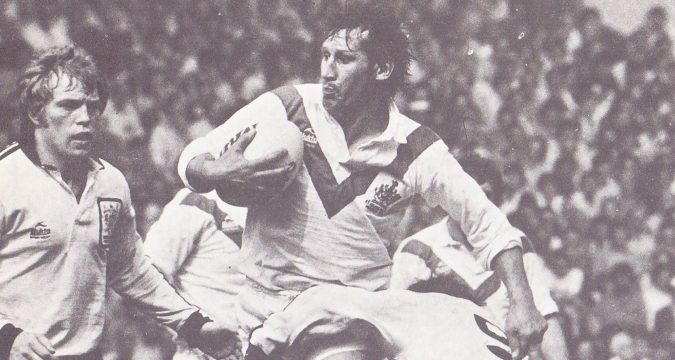
As we enjoy a nostalgic look back over 499 previous issues of Open Rugby and Rugby League World, something that stands out is just how much has changed, and yet how much really hasn’t.
CLUBS battling for survival amid rising costs and falling attendances in the face of competition from rival sports and other forms of entertainment.
Concerns over the loss of leading British players to Australia.
And debate over how the game should be structured and whether the value of televising matches in terms of income and increased profile outweighed the impact on the number of spectators going through the turnstiles.
Sounds familiar?
These were among the hot topics when Rugby League World launched as Open Rugby in May 1976, so it seems 500 issues and 48 years on, some things haven’t changed!
Back then, within the previous five years, the original Hunslet had gone to the wall and their Parkside ground had been bulldozed, although a phoenix version, New Hunslet based at the old Leeds Greyhound Stadium, were quickly formed.
Also at the end of the 1972-73 season, when Hunslet’s neighbours Dewsbury were unlikely league champions, the one-division system was dropped in favour of two with promotion and relegation.
The alarm bells had rung loudly when in the 1974-75 season, just 800,000 spectators in total watched league matches (in 1948-49, the figure was close to 7,000,000).
Down Under, clubs were in a healthier financial state through successful social clubs, and in a top-player drain, Penrith plucked Dewsbury hooker Mike Stephenson and Wigan centre or secondrow Bill Ashurst, while Castleford’s star loose-forward Mal Reilly and Hull KR backrow Phil Lowe were signed by Manly.
But there had been a boost for the British game in the form of the onset of sponsorship, evidenced by the Player’s No.6 Trophy, effectively a league cup and first played for in 1971-72.
The four-tackle set was upped to six in 1972 in an effort to encourage more entertaining play, and the value of field-goals halved to one point in 1974.
And also in 1974, the Rugby Football League appointed a new secretary-general (a highly influential position pre-chief executives) in David Oxley, a former schoolteacher from Hull who took the reins when Bill Fallowfield retired after almost 30 years in the post.
Oxley’s words on aspects of sponsorship and television coverage in an article written for the 1976 John Player Rugby League Yearbook are interesting.
On the former: “Sponsorship is a major source of central income and by far the most substantial is that derived from the Player’s No.6 Trophy, which has become second in prestige only to the Challenge Cup itself.
“There has been much talk recently of seeking a sponsor for the Challenge Cup. In my view, such talk is undesirable.
“A sponsor willing to pay the enormous sum necessary to ‘buy’ the Challenge Cup would naturally want the trophy to bear their name.
“The day the Challenge Cup becomes the Brand-X Cup will be the day its integrity is compromised, its glamour tarnished, and its appeal irrevocably diminished.”
Within three years, it had become the State Express Challenge Cup.
And on television: “Rugby league’s most lucrative form of income is also the most controversial, and is hotly debated, with the contention that live matches and falling gates are inevitably interlinked.
“My firm conviction is that any game which represents itself as a major spectator sport must lend itself to regular exposure on television. Any major sport which retreats from television is dead.”
Oxley was still in post when games were first screened in 1990 by British Satellite Broadcasting, soon to merge with Sky, with the resulting company of course central to the creation of Super League and switch to summer rugby in 1996.
Back in 1976, what happened in the high-profile matches which were broadcast on the small screen?
There was trophy domination by teams west of the Pennines, with only the Yorkshire Cup won by a white-rose side, Syd Hynes’ Leeds beating Hull KR 15-11 in the November final played at their own Headingley ground and watched by 5,743.
Slick Salford, coached by Les Bettinson and with Welsh rugby convert Maurice Richards and ex-England union star Keith Fielding among the tries and David Watkins, another former Wales rugby union international, kicking plenty of goals, won a second league title in three seasons.
Meanwhile St Helens claimed three pieces of silverware and Widnes two.
First into the Saints cabinet was the BBC2 Floodlit Trophy, won just before Christmas via a 22-2 victory over Dewsbury in the final, played at Knowsley Road in front of 3,858.
Eric Ashton’s side then made it to Wembley, beating Hull, Salford, Oldham and Keighley en route to a Challenge Cup final showdown with Widnes, who were defeated 20-5 with the help of two tries by replacement back Peter Glynn before 89,982.
Later in May, Saints won the end-of-season Premiership (the replacement for the old play-offs) 15-2 against Salford, who were overwhelmed in the closing stages of a final played at Station Road Swinton, where 18,082 were present.
Having played 52 times in total that season, super-fit ‘Super Saints’ then undertook a two-week club tour of Australian and New Zealand.
It featured the first, albeit unofficial, World Club Challenge, won 25-2 by Eastern Suburbs at Sydney Cricket Ground and watched by 26,865.
Frank Myler’s Widnes won the Lancashire Cup in October with a 16-7 triumph over Salford at Wigan’s Central Park, where the gate was 7,566.
Then 8,990 turned out at Headingley in January to witness their 19-3 win over Hull in the final of the Player’s No.6 Trophy.
First published in Rugby League World magazine, Issue 500 (September 2024)
Click here to subscribe to the print edition of Rugby League World
